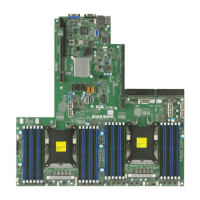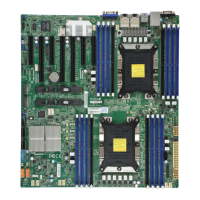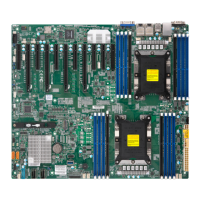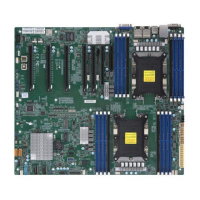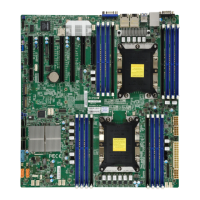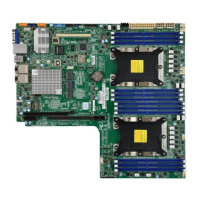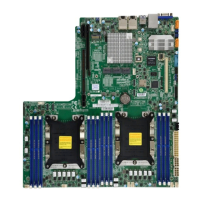Do you have a question about the Supermicro X11DPT-B and is the answer not in the manual?
Introduces the motherboard and its purpose as an industry leader's product.
Details the Intel Xeon Scalable-SP processors and the Intel C621 chipset.
Describes health monitoring features supported by the ASPEED AST 2500 BMC.
Explains onboard voltage, fan status, and environmental temperature monitoring.
Details Advanced Configuration and Power Interface features for power management.
Stresses the importance of a stable power source for reliable operation.
Covers new advanced power management features like Management Engine (ME).
Introduces DCPMM technology for persistent memory with higher capacity and lower latency.
Summarizes key hardware components, features, and specifications of the motherboard.
Provides precautions for handling components to prevent ESD damage.
Details the process of mounting the motherboard into a chassis using mounting holes and standoffs.
Provides instructions and warnings for installing CPUs and heatsinks correctly.
Details motherboard memory support, types, and installation sequence.
Describes the location and definition of various I/O ports on the motherboard's rear panel.
Explains JF1 header pins for chassis buttons and indicators.
Details the pin definitions for onboard fan headers (FAN3/4).
Explains how jumpers modify motherboard operation and how to clear CMOS.
Describes IPMI LAN LEDs for connection speed and activity.
Lists and describes the five PCIe 3.0 slots available on the motherboard.
Provides systematic procedures to diagnose and resolve system issues.
Guides on how to identify and resolve memory-related issues.
Outlines steps to take before contacting technical support and information to provide.
Addresses common questions regarding memory support, power switch, and BIOS updates.
Provides instructions for safely removing and installing the onboard CMOS battery.
Explains the process for obtaining warranty service and RMA authorization.
Introduces the AMIBIOS setup utility and how to enter it.
Explains the main BIOS setup screen and its components like system date/time and version info.
Details various advanced BIOS settings including boot configuration.
Details how to configure SMBIOS Event Log settings, including enabling, erasing, and handling full logs.
Covers Intelligent Platform Management Interface (IPMI) settings for BMC firmware and system event logs.
Allows configuration of system security settings, including administrator and user passwords.
Configures system boot settings, including boot mode, EFI support, and boot order priorities.
Provides options for saving changes, discarding them, and exiting the BIOS setup utility.
Explains UEFI BIOS POST codes and how to use diagnostic cards for troubleshooting.
Guides through the process of installing Microsoft Windows OS, including driver loading.
Instructs on downloading and installing system drivers and utilities from the Supermicro website.
Introduces SuperDoctor 5 for system health monitoring and management.
Explains IPMI support for remote access, monitoring, and management.
Details how to log into the BMC using the provided unique password.
Provides warnings about battery replacement dangers and proper disposal methods.
Explains UEFI as a software interface between OS and platform firmware.
Describes the UEFI BIOS structure and the process of recovering a corrupted BIOS image.
Details the procedure for recovering the main BIOS image using a USB device.
Provides instructions to access the All Intel VMD Controllers menu for PCI slot VMD support.
Guides on configuring RAID settings for NVMe devices.
Describes the use of a journaling drive for RAID5 volumes to mitigate data loss.
Guides on selecting the boot mode (LEGACY, UEFI, DUAL) in BIOS Setup.
Explains how to configure Secure Boot, its modes, and CSM support.
Details steps to enable Secure Boot, set its mode, and configure CSM support.
Describes key management options for secure boot, including provisioning factory defaults.
Guides on accessing PCIe/PCI/PnP configuration within BIOS for iSCSI settings.
Explains how to configure iSCSI settings, starting with the initiator name.
Describes how to configure onboard Intel LAN devices via BIOS Setup utility.
| CPU Socket | LGA 3647 |
|---|---|
| Chipset | Intel C621 |
| Memory Type | DDR4 |
| Max Memory | 2 TB |
| M.2 Slots | 1 |
| SATA Ports | 8 |
| LAN Ports | 2 |
| Video Ports | 1 |
| PCIe 3.0 x16 Slots | 4 |
| PCIe 3.0 x8 Slots | 2 |
| Power Connector | 24-pin ATX |
| Memory Slots | 16 |

